You are here
Home › Research › RTTA 3: Anticipation & Deliberation › RTTA 3/4: Futurescape City Tours › Session IISession II
Last Updated: June 25, 2013
Tour Preparations for Session II
After the Orientation Session, we had the list of citizens’ ![]() concerns.docx from which we derived themes to narrow down some possible sites for the tour. It was easy to come up with 3 to 5 shared interests and concerns.
concerns.docx from which we derived themes to narrow down some possible sites for the tour. It was easy to come up with 3 to 5 shared interests and concerns.
We then sat down with a google map of the city and looked at what places and spaces might allow us to visit and discuss in relation to those themes. This part takes some patience as you will have to balance the strategies of taking a tour (walking, riding, physically moving a group from place to place) against the participants’ interests. We also tried to make some of the sites in locations to which participants would not otherwise have access.
We chose three main sites to visit (focused on solar energy, water, and DIY biofuels) and orchestrated a lunchtime panel (on public transportation). Our goal was to identify at least one expert and one stakeholder who could participate per site. In addition to the sites and the panel, we planned several 'sidebars', smaller stops along the way to explore an issue about nanotechnology in the city. For Phoenix, this was examining a graffiti corridor to discuss the societal implications of anti-graffiti nano paint, a parking lot to discuss multi-functional asphalt and maintaining of urban infrastructure, and the role of nanotechnology in preserving historical buildings.
Our goal was to identify at least one expert and one stakeholder who could participate per site. We purposely invited scientists at various stages of their careers to fulfill the expert role. Generally though, the “scientific expert” was a person who worked in the university conducting some variety of research related to the larger topic (photovoltaics for instance).
The stakeholders could include representatives from local corporations, civic and community leaders (we invited the principal and a student from a local high school whose solar panels we visited), non-profit professionals, or other types of policy makers (we invited a man whose sole purpose was to manage traffic signals to improve traffic flow in the City of Chandler).
During this phase we contacted these experts and stakeholders, ![]() inviting.doc them to be a part of the tour and providing them with guidelines of how to participate.
inviting.doc them to be a part of the tour and providing them with guidelines of how to participate.
We instructed them in detail about the type of interaction they would have with participants (see ![]() solar_energy_example_stakeholder_email.doc. )
solar_energy_example_stakeholder_email.doc. )
This stage takes some patience, especially when talking to some of the larger, more complex organizations (like the Transit Authority). We crossed folks off our list who looked good on paper, but were notorious for their inability to speak more generally and approachably about their work’s relationship to society, particularly Phoenix. We, of course, did not know or have the time to watch everyone we invited perform in a public space beforehand. This was especially true for the civic organizations which we contacted. We had to accept whoever they volunteered to us as their representative. Nevertheless, before the tour we spoke to everyone in person, not just via email, to explain in detail what was expected of them. Namely, that they were to serve a role in a conversation with interested citizens about their topic (transportation, water/canal, solar panels, or bio fuels).
To make sure we wound up with the right number of representatives, we talked with more people than we probably needed, in case anyone fell through. In addition, we were still talking and cajoling right up until the week that the tour took place, which was nerve wracking. Be prepared!
We also created Pre-Reading and Viewing Materials for the tour participants. We sent this ![]() reminder_email_for_session_ii.doc announcing the suggested background resources, which included scientific papers, TED talks, videos, and other types of journal articles and blogs. We also included follow-up reminders alerting participants to bring cameras, sun screen, comfortable shoes etc.
reminder_email_for_session_ii.doc announcing the suggested background resources, which included scientific papers, TED talks, videos, and other types of journal articles and blogs. We also included follow-up reminders alerting participants to bring cameras, sun screen, comfortable shoes etc.
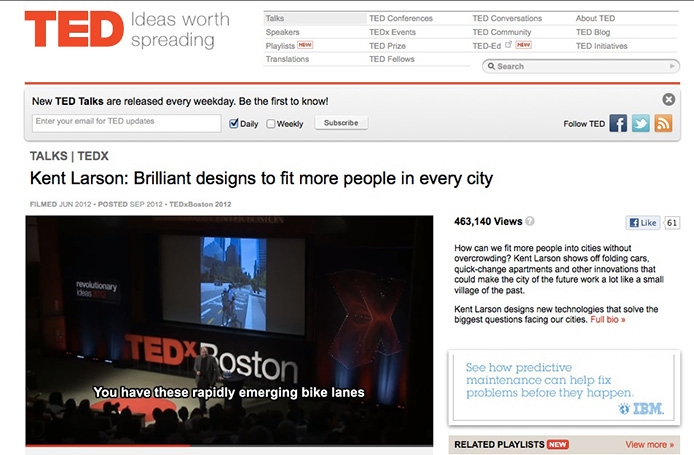
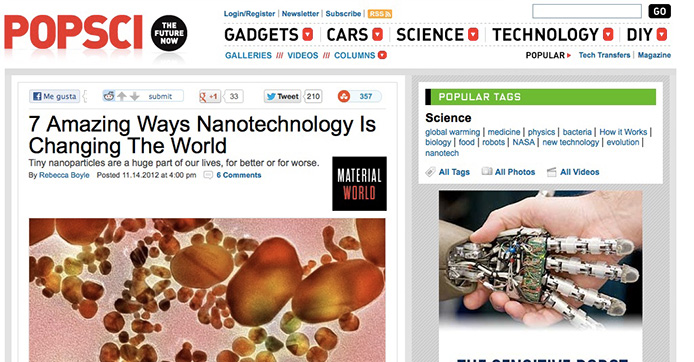
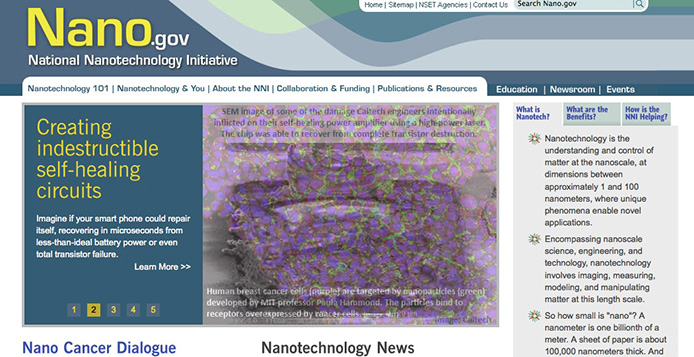
We created a Tour Workbook (![]() fct_booklet_v11.docx) designed to give participants a chance to record their thoughts, tracking some of their observations of the past, present, and future. The workbook was another tool to think with: a place participants could record their questions and thoughts along the way and a place we could then view those comments afterwards. The books were set up to include a bit of information about all of the stops along the tour, as well as pictures of some of those stops from earlier in the 20th century. In addition, the book included directions
fct_booklet_v11.docx) designed to give participants a chance to record their thoughts, tracking some of their observations of the past, present, and future. The workbook was another tool to think with: a place participants could record their questions and thoughts along the way and a place we could then view those comments afterwards. The books were set up to include a bit of information about all of the stops along the tour, as well as pictures of some of those stops from earlier in the 20th century. In addition, the book included directions ![]() flickrguide.pdf for how to use Flickr and what to do with their photos after the tour. The workbook was also a place to put the contact information and/or bios of the speakers.
flickrguide.pdf for how to use Flickr and what to do with their photos after the tour. The workbook was also a place to put the contact information and/or bios of the speakers.
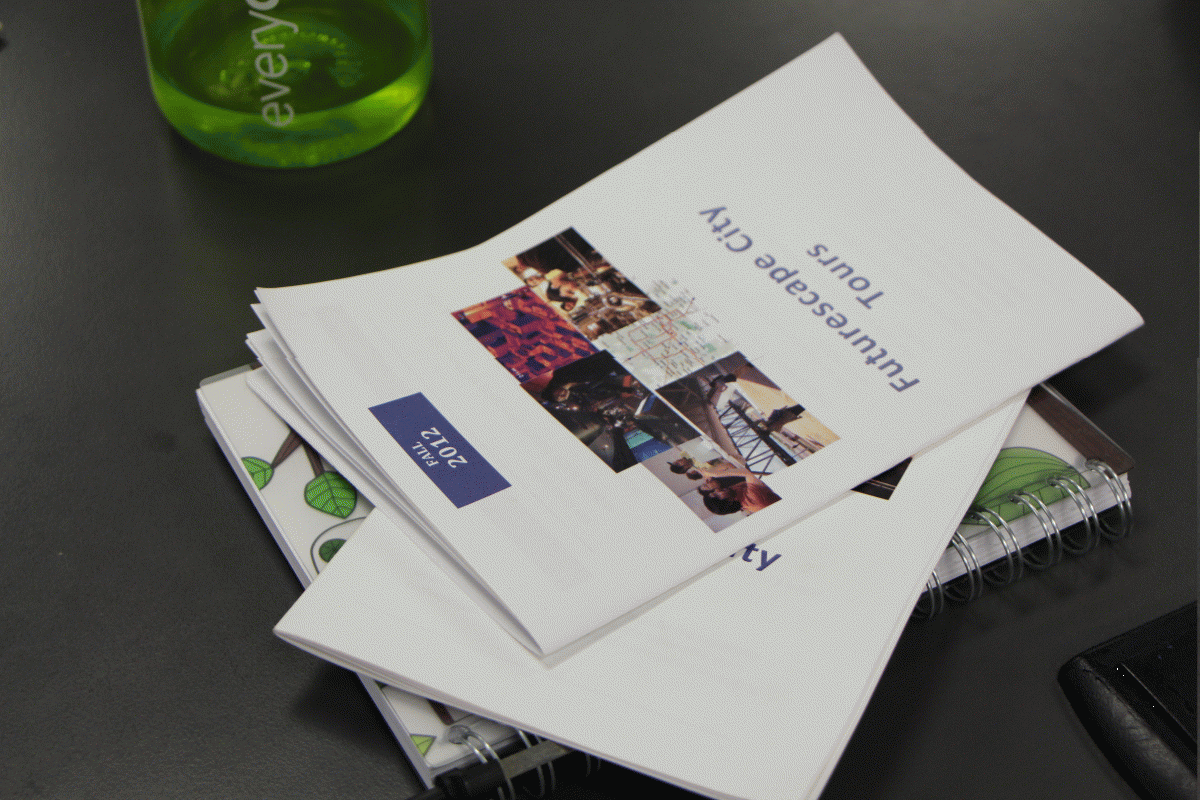
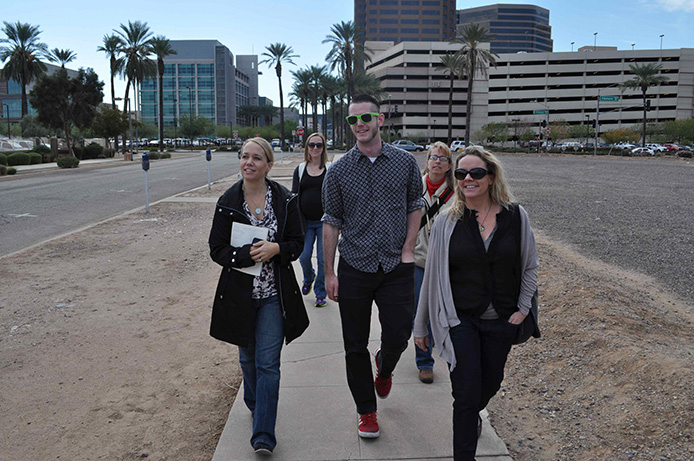
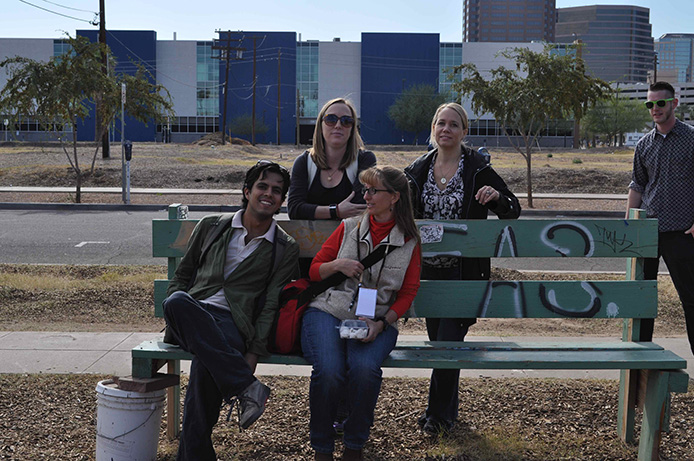
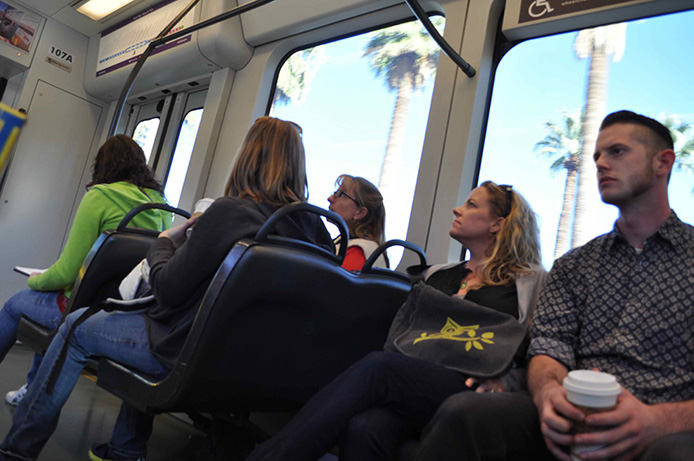
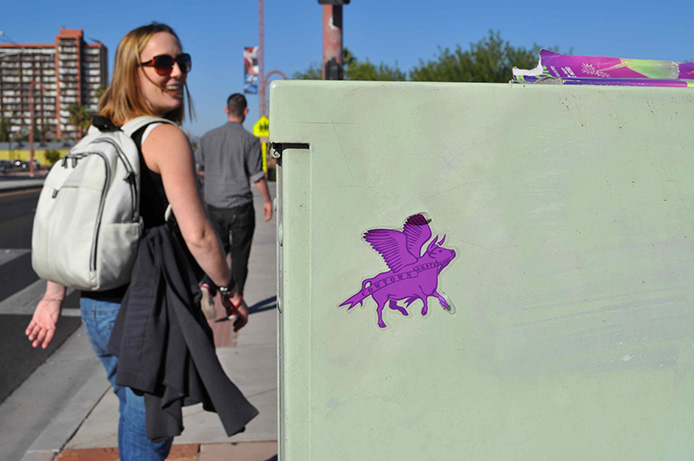
After we took the practice walk, we reduced down the number of sites and added more individualized thinking time. For example, while riding on the light rail we purposely added an “observation and thinking” exercise based on a question in their workbooks. This was after lunch and toward the end of the tour, so some quiet reflection time allowed people to recuperate before the last interaction. Originally we had planned another mini-stop along the path between stops three and four, but when we took the tour ourselves, we were exhausted by the afternoon/evening. We felt that it took a lot of energy and focus to participate in each of the conversations in addition to the taking of pictures and the shorter impromptu events along the way. Keeping things simpler, in fact, improved folks’ abilities to participate in the last event and allowed them the last bit of stamina to participate in the wrap up. Plus, it meant if people wanted to stop and take the time to take pictures and observe while we walked, they were not rushed.
Here is the Powerpoint from our April training about pre-Session II work.
Session II: The Tour
Here is our ![]() fct_tours_agenda.v3.doc for the tour. The following explains our tour, where we went, and what we tried to achieve at each site and by each conversation. We handed out bags with donated bottles of waters, snacks, pens, the workbook, and name tags. We brought cameras for those who had requested them.
fct_tours_agenda.v3.doc for the tour. The following explains our tour, where we went, and what we tried to achieve at each site and by each conversation. We handed out bags with donated bottles of waters, snacks, pens, the workbook, and name tags. We brought cameras for those who had requested them.

Bags and Name Tags (Session 2_7)
 Using Bags and Cameras (Session 2_17)
Using Bags and Cameras (Session 2_17)
We began the tour at the local science center which was hosting the NISE Network’s mini-nanoexhibit. The Science Center is located in Phoenix’s Heritage Park, a community space that allowed us to talk about what’s at stake in the preservation of history, how and who gets to determine what to preserve, and what role do these community spaces play in citizen’s ability to interact with one another and with shaping the changes in their community. These were topics in which the participants had expressed interest.
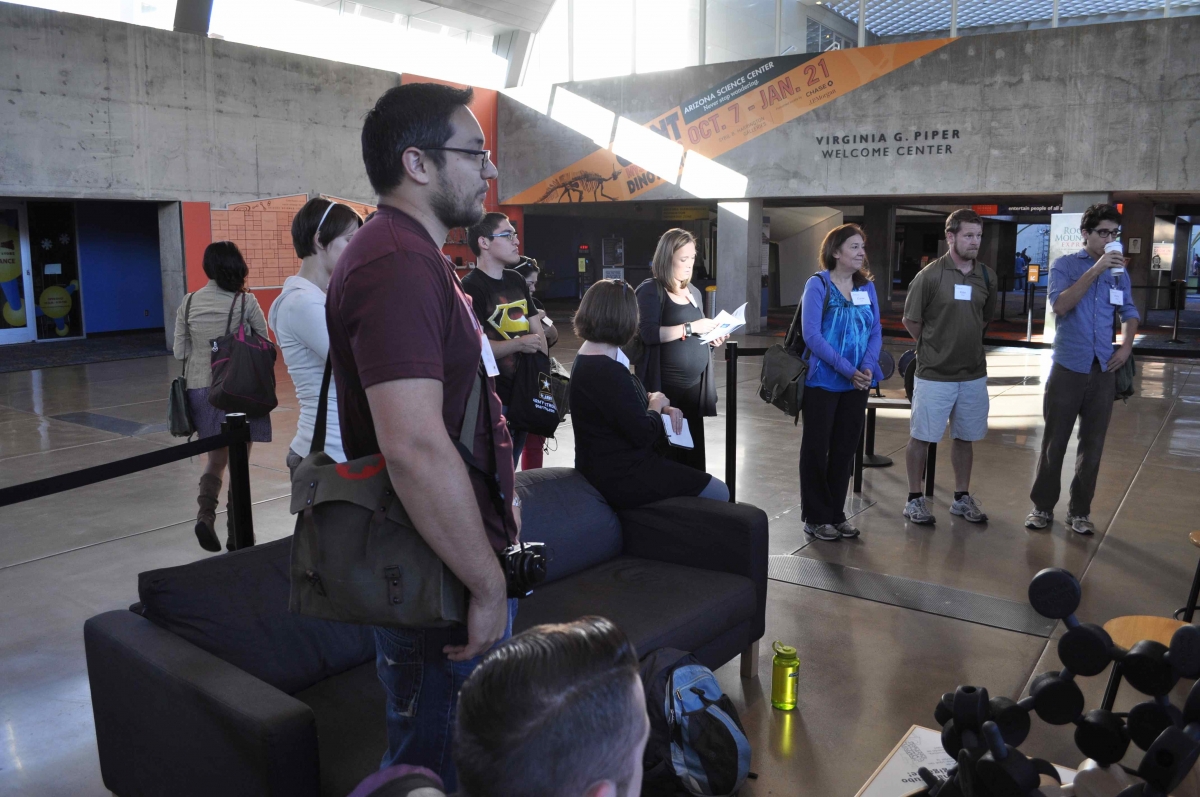 At the Science Center (Session 2_1)
At the Science Center (Session 2_1)
While we transported ourselves along to each primary site, we planned short conversations about things we witnessed along the way. For instance, there’s an alley full of high-end graffiti art that our participants, even those who walked in Phoenix frequently, had never seen. We talked about the values and ethics of using nanopaint which could prevent graffiti art from sticking. These “impromptu” stops also allowed the participants to take pictures and observe that which they didn’t ordinarily pay attention.
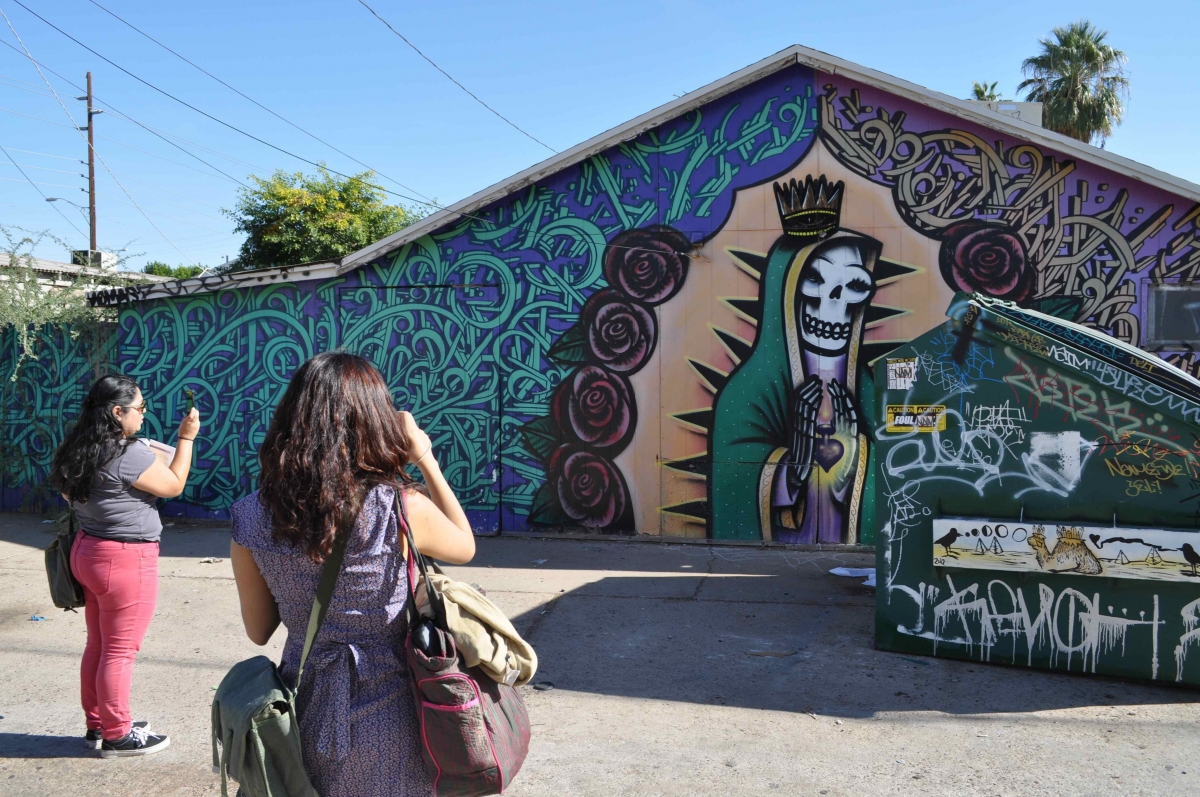 Graffiti Conversation (Session 2_10)
Graffiti Conversation (Session 2_10)
For solar, our first stop, we climbed a ladder to the roof of a local high school where Intel had sponsored the installation of a set of solar panels. While standing around and interacting with the solar panels, we had the principal, a representative from Intel, a scientific expert on photovoltaics from ASU, and a student who conducts research using the panels available to discuss the role of solar in Phoenix. Before asking them to speak, we summed up the participants’ concerns and interests that had been mentioned at Session I, in relation to solar, and then asked the invited speakers to share some of their knowledge in relation to these interests and concerns. Some of this included explaining how and why the solar panels ended up on the roof of the high school.
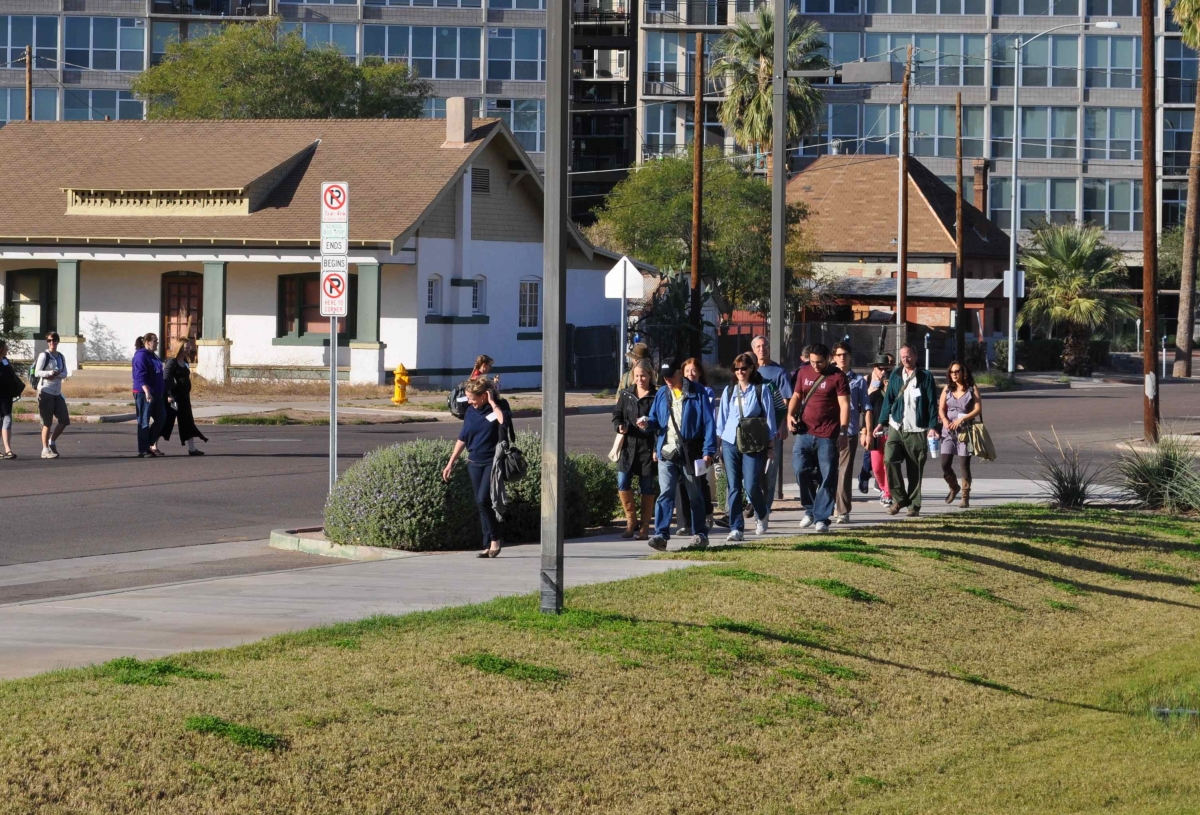 Arriving at BioScience High School (Session 2_2)
Arriving at BioScience High School (Session 2_2)
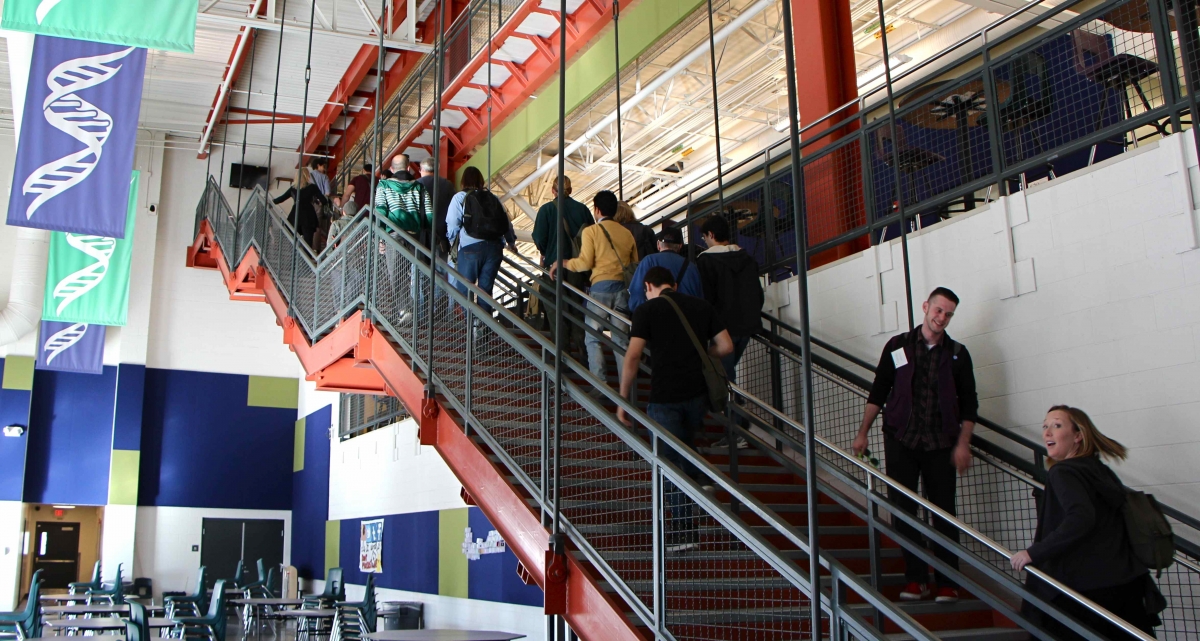 Going to the Roof (Session 2_8)
Going to the Roof (Session 2_8)
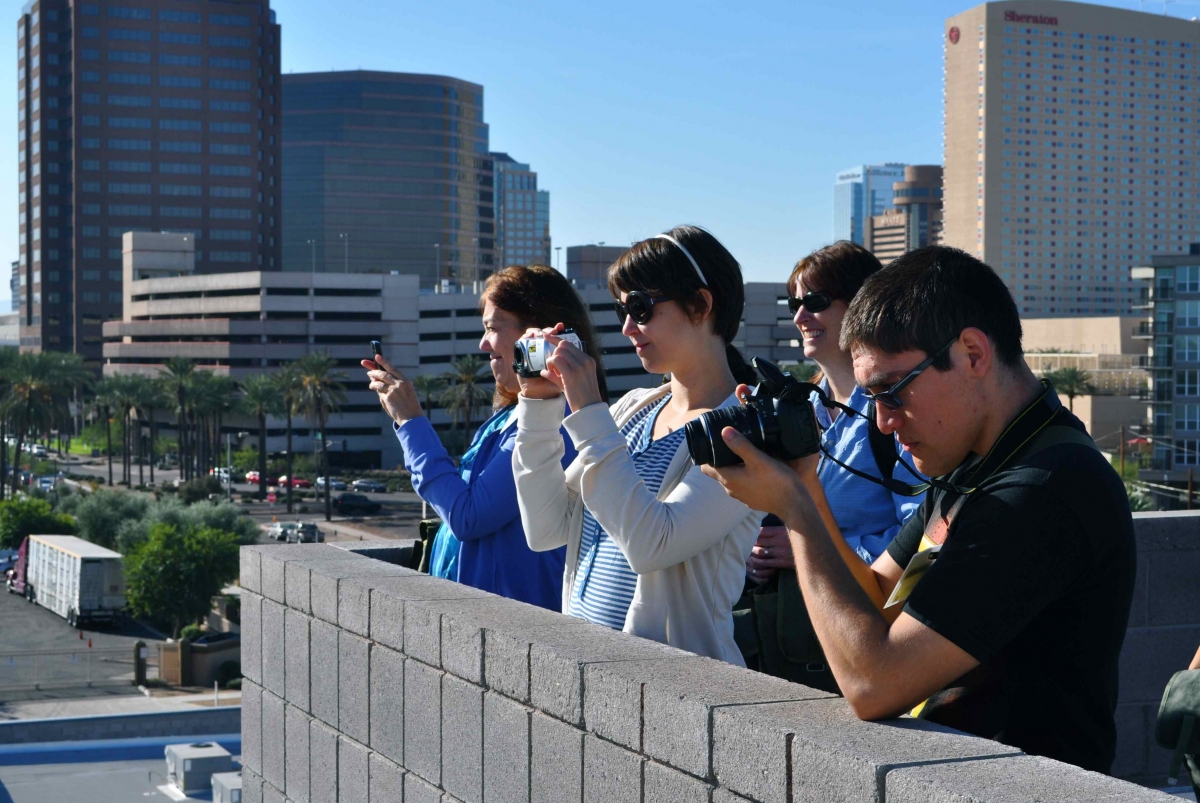 Looking at the Solar Panels (Session 2_3)
Looking at the Solar Panels (Session 2_3)
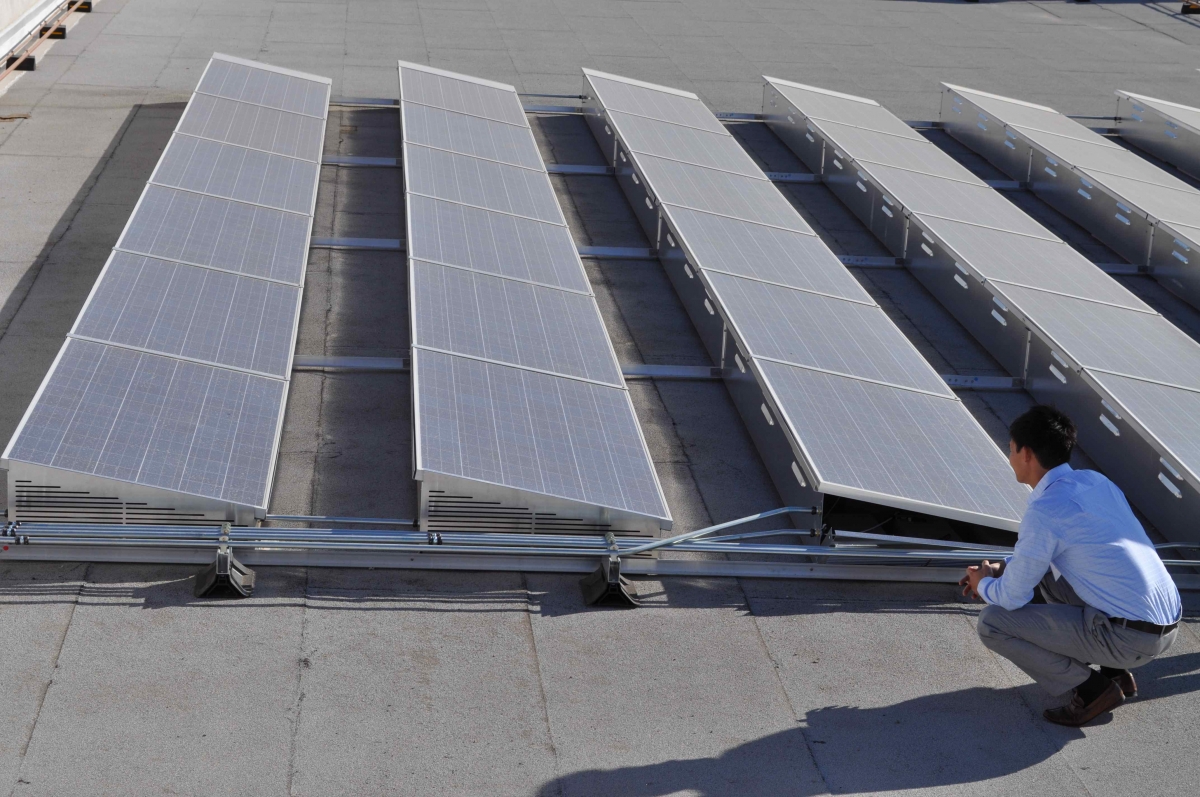 Solar Panels (Session 2_4)
Solar Panels (Session 2_4)
The other learning and communication strategies we used were a DIY demonstrate of how to make biofuels. This occurred outside, in the back yard of a local vegan café. Participants could sit down, relax, and munch a little bit in addition to participating in the DIY demonstration.
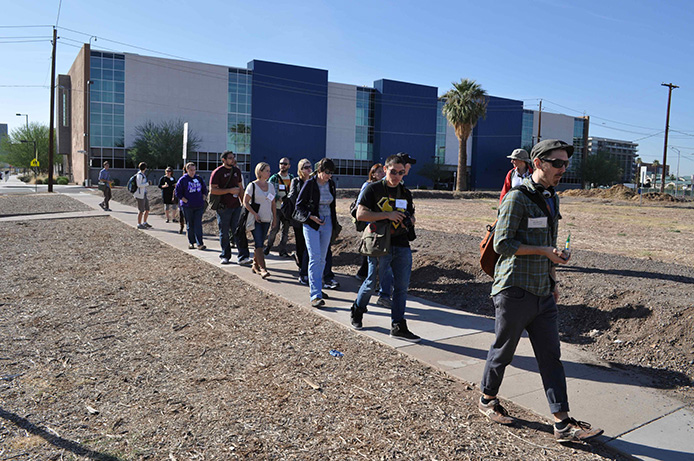 Walking Toward the Second Stop: BioFuels, Community Garden & Coffee Shop (Session 2_5)
Walking Toward the Second Stop: BioFuels, Community Garden & Coffee Shop (Session 2_5)
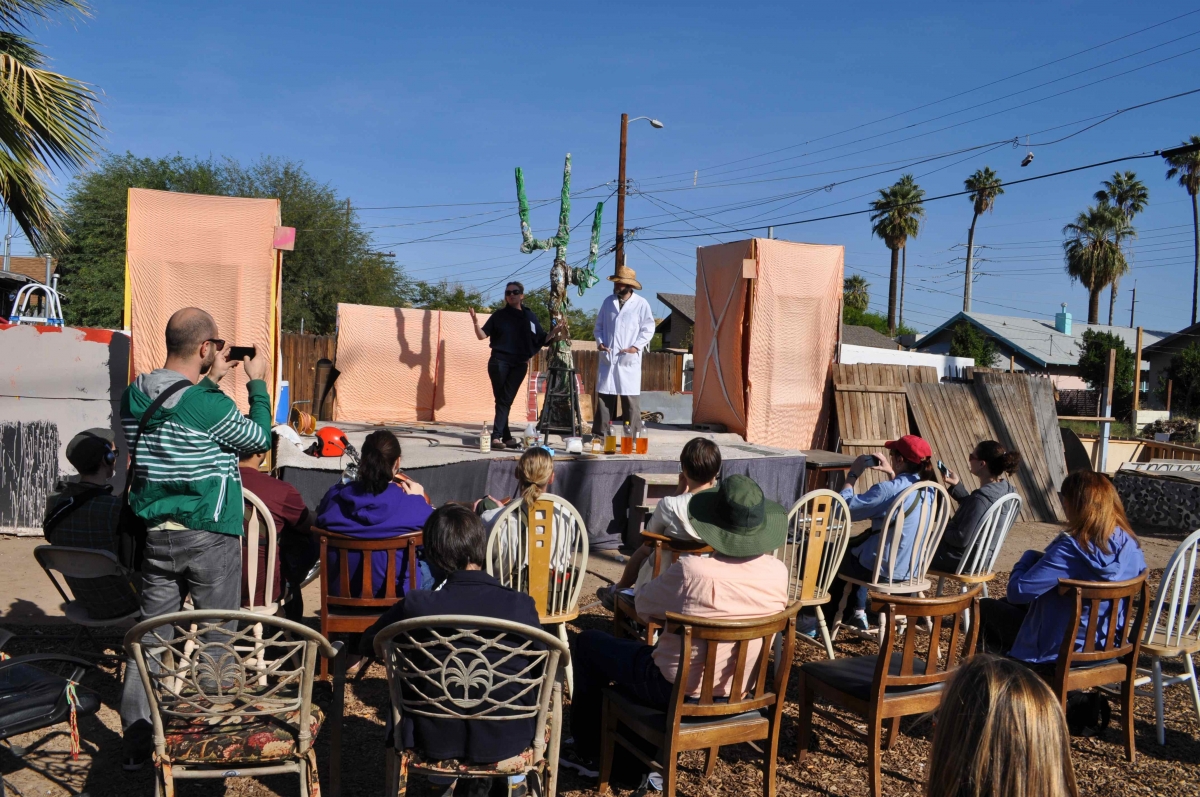 Professor Beer's DIY Lesson (Session 2_6)
Professor Beer's DIY Lesson (Session 2_6)
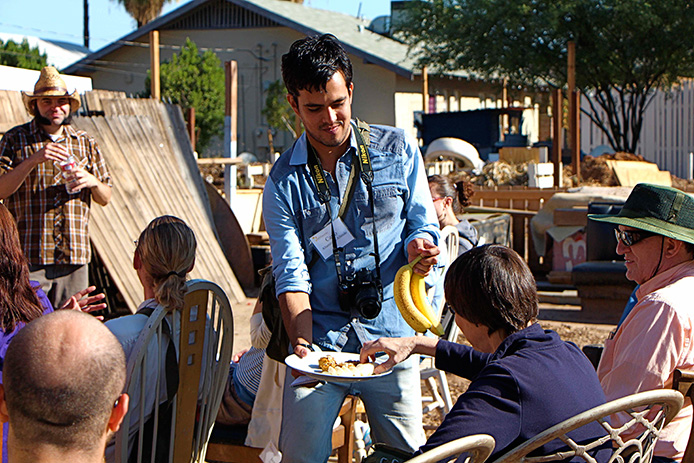 Serving Refreshments (Session 2_9)
Serving Refreshments (Session 2_9)
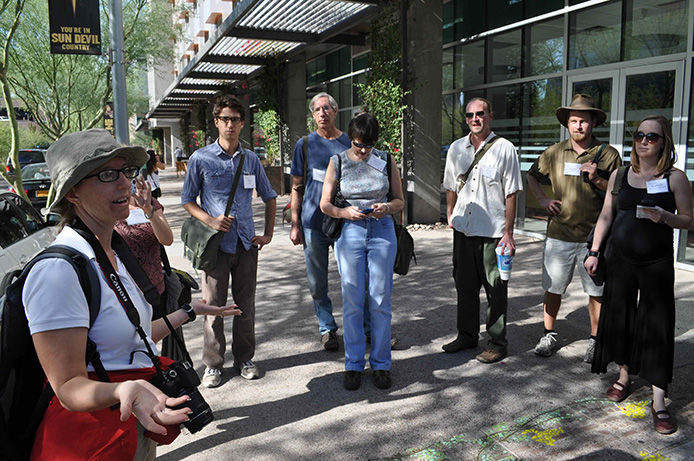 On our way to the Transportation Panel: Nano and Pavement (Session 2_11)
On our way to the Transportation Panel: Nano and Pavement (Session 2_11)
Our third stop was the most formal. We sat inside a conference room, had lunch delivered, and listened to a panel of experts on transportation. Rather than having the panel’s experts just talk and then field questions, we gave each speaker five minutes to explain what he/she does and how that might be significant to our participants. Then the participants were broken up into groups of three and four and they had to discuss amongst themselves what they thought was most significant about transportation in their community.
We asked them to settle on a point or question that they could present to the group about what was the most important challenge facing transportation in their communities. Then each group presented its question as part of a large conversation in which the panelists provided some responses. We allowed the conversation to develop organically, but also watched the clock so that every group had a chance to present its views in the large discussion. The moderation of this session was very important. These speakers had a tendency to be less focused so even though we had spoken with them before hand, it was important that we limited the amount of time they had to speak in order to maximize the ability of the citizens' to voice their concerns and query the panel.
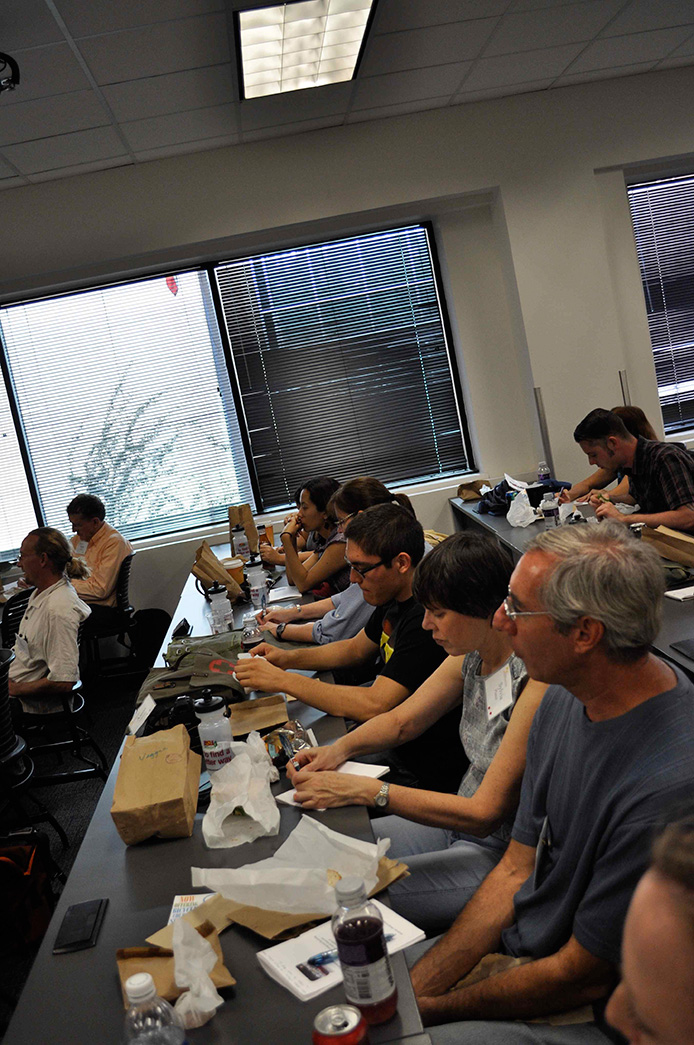 Lunchtime Conversation at ASU's Downtown Campus (Session 2_12)
Lunchtime Conversation at ASU's Downtown Campus (Session 2_12)
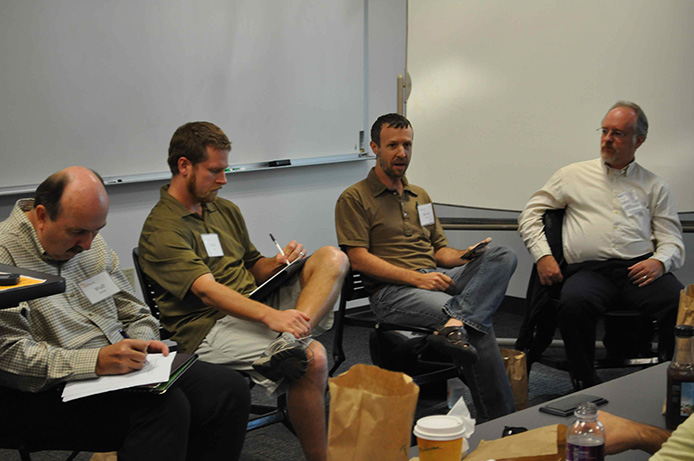 Panel on Transportation (Session 2_13)
Panel on Transportation (Session 2_13)
After lunch we took the light rail to the last stop, a walk along the grand canal. Here we had two graduate students and one early career social scientist give 3 to 5 minute presentations of what they do. Two of the speakers were traditional scientists who worked with different aspects of nanotechnology and water, while the third was an interdisciplinary social scientist who works with Native tribes in Arizona and their negotiations with the Federal Government over water and land use on their tribal lands. We broke up into three groups and each group walked along the canal for five to 10 minutes discussing water in relationship to some of the issues the speaker brought up. After 10 minutes we switched speakers so that every small group had the chance to walk and chat with every speaker.
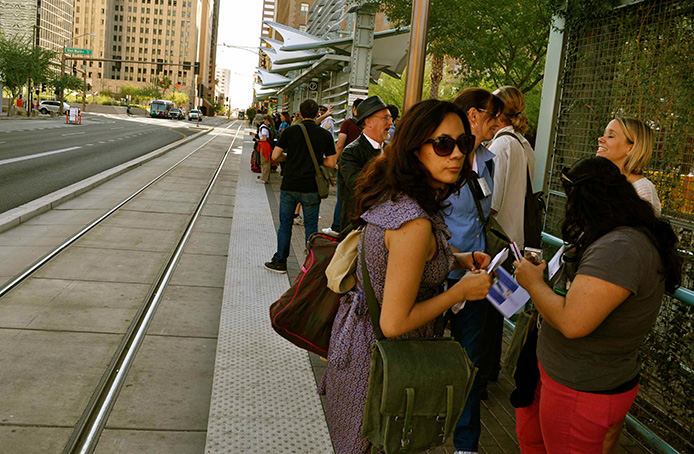 Observing the landscape while waiting for the light rail (Session 2_14)
Observing the landscape while waiting for the light rail (Session 2_14)
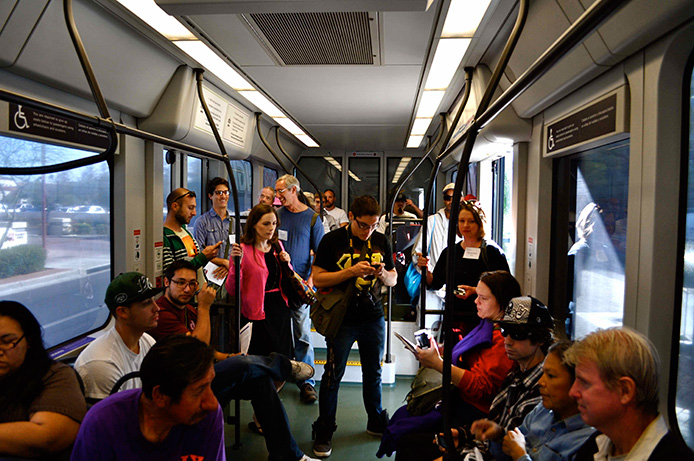 Silent Observation on the light rail (Session 2_15)
Silent Observation on the light rail (Session 2_15)
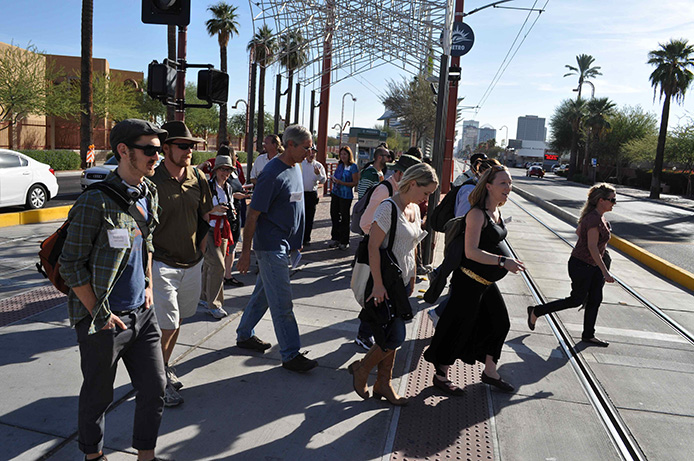 Walking Toward the Canal (Session 2_16)
Walking Toward the Canal (Session 2_16)
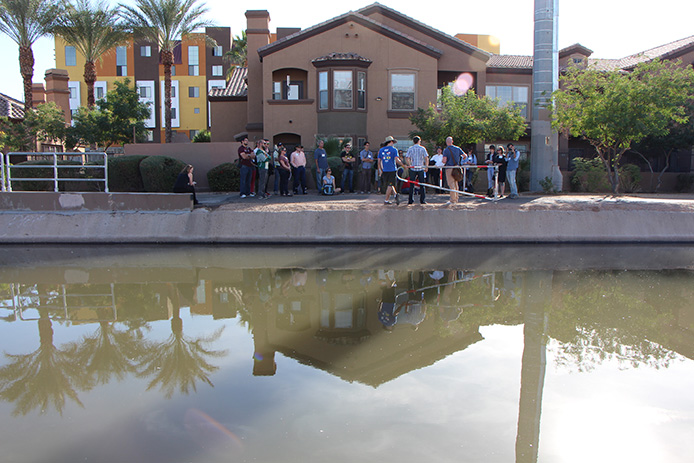 Beginning of Canal Conversation (canal_talk)
Beginning of Canal Conversation (canal_talk)
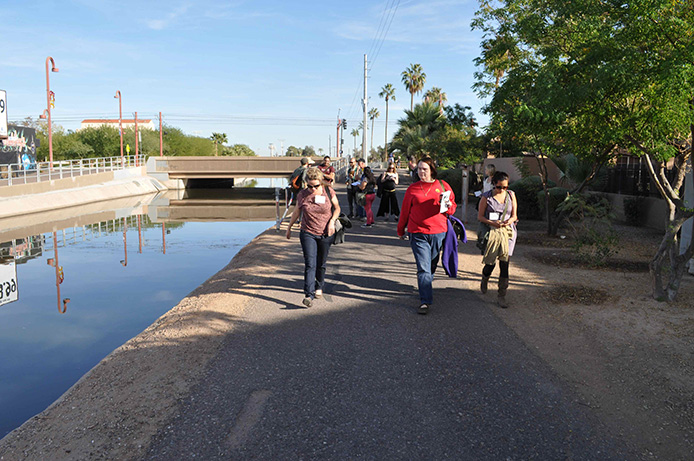 Walking along the canal (Session 2_18)
Walking along the canal (Session 2_18)
We then got back on the light rail and returned to the science center where folks were departing from. Before letting people go, we had a brief discussion about participants’ first impressions of the day. These were some of the best comments were received all day and we emphasize the need to record these interactions and words.
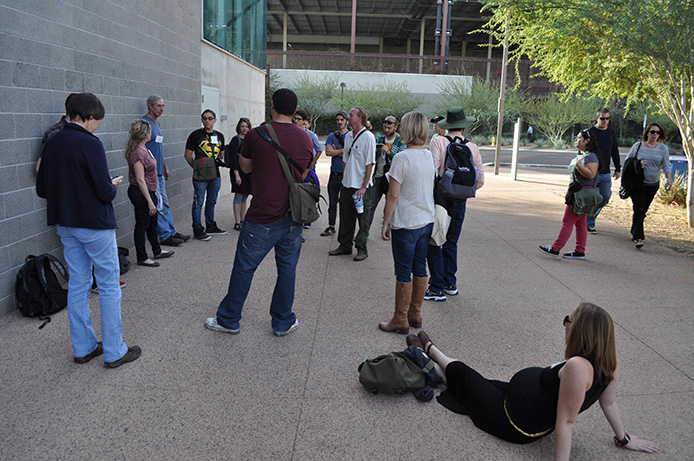 Final Debrief outside the Science Center (Session 2_19)
Final Debrief outside the Science Center (Session 2_19)
Brief Outline of Session II Agenda:
- 8:45 AM to 9:00 AM: Arrival
- 9:00 AM: Remind Participants of the goals of the day, including taking pictures.
- 9:10 AM: Begin Walking through Heritage Park talking and taking pictures.
- 9:30 AM to 10:30 AM: Solar at Bioscience High school, leave in time to walk to café by 10:30.
- 10:30 AM to 11:30 AM: Aside of Heart Café, Bio fuels Demo
- 11:30 AM to 12:00 PM: Walk through Graffiti Alley and have brief discussion about nanopaint. Walk by parking lot and have brief discussion of nano coatings to reduce heat islands in parking lots.
- 12:00 PM to 1:30 PM: Transportation Panel and Lunch
- 1:30 PM to 2:30 PM: Walk to Light rail. Do Light rail observation. Walk to Grand Canal.
- 2:30 PM to 3:30 PM: Walk the Grand Canal Trail
- 3:30 PM to 4:30 PM: Return to Science Center via Light Rail. Conduct debrief before participants depart.
Here is the Powerpoint from the April training session about Session II.
powerpoint link


